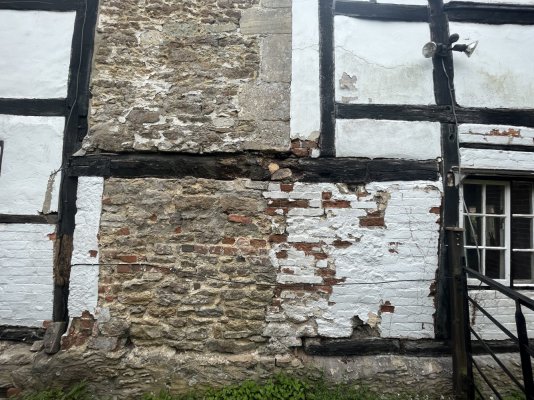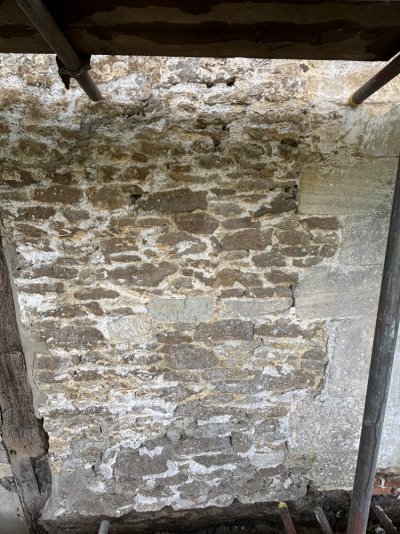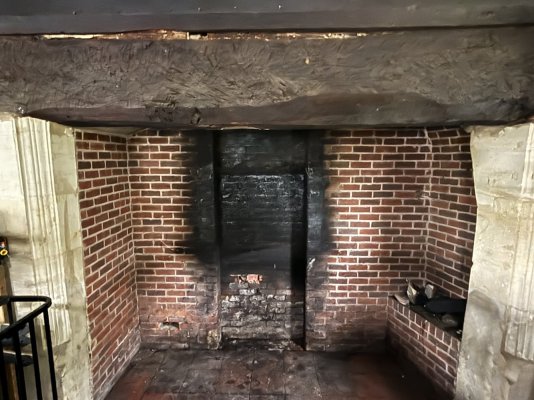You are using an out of date browser. It may not display this or other websites correctly.
You should upgrade or use an alternative browser.
You should upgrade or use an alternative browser.
External Timber Lintel
- Thread starter aockenden
- Start date
malcolm
& Clementine the cat
- Messages
- 1,885
- Location
- Bedfordshire
It's fine to leave timber exposed so long as it isn't painted with anything waterproof and there isn't water directed at it. Chances of achieving that in the long term when you aren't looking after the building would be pretty slim. Lime render with some sort of drip edge would probably give it a better chance in the longer term.
ok so if I decide to lime render over it, what sort of “lath” system would be most appropriate to fix over it? Does it need anything at all? It’s a fairly rough-sawn piece of wood.It's fine to leave timber exposed so long as it isn't painted with anything waterproof and there isn't water directed at it. Chances of achieving that in the long term when you aren't looking after the building would be pretty slim. Lime render with some sort of drip edge would probably give it a better chance in the longer term.
Depending how deep you’re rendering - hack away as they used to with the tell tale pock marks, and / or pepper with SS screws for a key.ok so if I decide to lime render over it, what sort of “lath” system would be most appropriate to fix over it? Does it need anything at all? It’s a fairly rough-sawn piece of wood.
Flyfisher
Member
- Messages
- 10,484
- Location
- Norfolk, UK
I suppose it depends on what type of wood the lintel is made of and how long you want it to last. I have exposed oak that is over 400 years old and is still rock-hard, albeit a bit gnarly. I've also replaced rotten lintels with new oak and have done nothing except limewash over them. I'm not expecting them to need any other maintenance while I'm still on the planet.
Absolutely fine, assuming the timber is adequately protected from water run off / pooling. And of course that it’s a nice piece of oak.Hey what are everyone’s thoughts on leaving a timber lintel exposed on the external face of a wall? The other obvious option is to lime render over it (after fixing some kind of lath) along with the rest of the building.
We have a trunk inserted across our chimney stack externally, it was put in a few hundred years ago as a prop to hold up the stack above while the lower level was opened to replace a failed lintel on the main fireplace behind. Effectively a temporary lintel, that was never removed. They sensibly projected the rubble stonework above to shed water away from the timber, but under the flush quoin, the water run off has taken us down to just a couple of inches of good hard wood remaining…that was once a decent chunk of oak also, but more than the sappy outer has been taken from endless dripping.
Assuming you’re taking window/door, then I’m a big fan of pentice boards.


Do you have pics of these pock-marks? I must say I’m loathe to start hacking into my structural lintel..,Depending how deep you’re rendering - hack away as they used to with the tell tale pock marks, and / or pepper with SS screws for a key.
Don’t think I have a more zoomed in shot to hand easily… should be able to make them out. I’ve only ever seen them for internal plaster covering, but the principle stands. You’ll be doing no damage to the integrity, think of it as no more than using a devil float …
PS this is the reason for the excavation in the external wall, failed original stone lintel replaced with a monster chunk of oak, once presumably plastered over to replicate the previous moulding and tie in with the jambs.

PS this is the reason for the excavation in the external wall, failed original stone lintel replaced with a monster chunk of oak, once presumably plastered over to replicate the previous moulding and tie in with the jambs.

The wood species is a mystery as I’ve repurposed an old beam off a Dutch barn we took down.I suppose it depends on what type of wood the lintel is made of and how long you want it to last. I have exposed oak that is over 400 years old and is still rock-hard, albeit a bit gnarly. I've also replaced rotten lintels with new oak and have done nothing except limewash over them. I'm not expecting them to need any other maintenance while I'm still on the planet.
